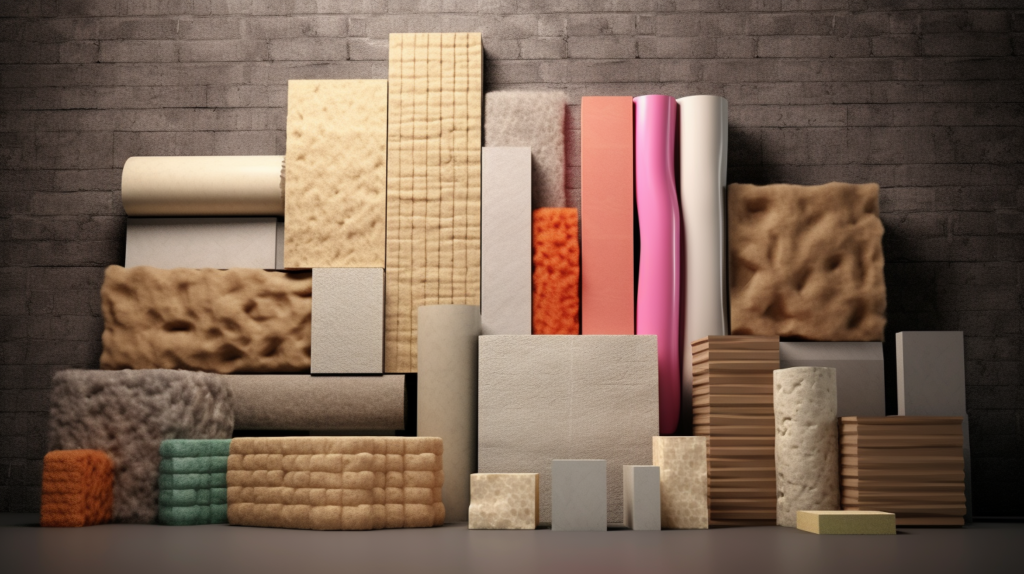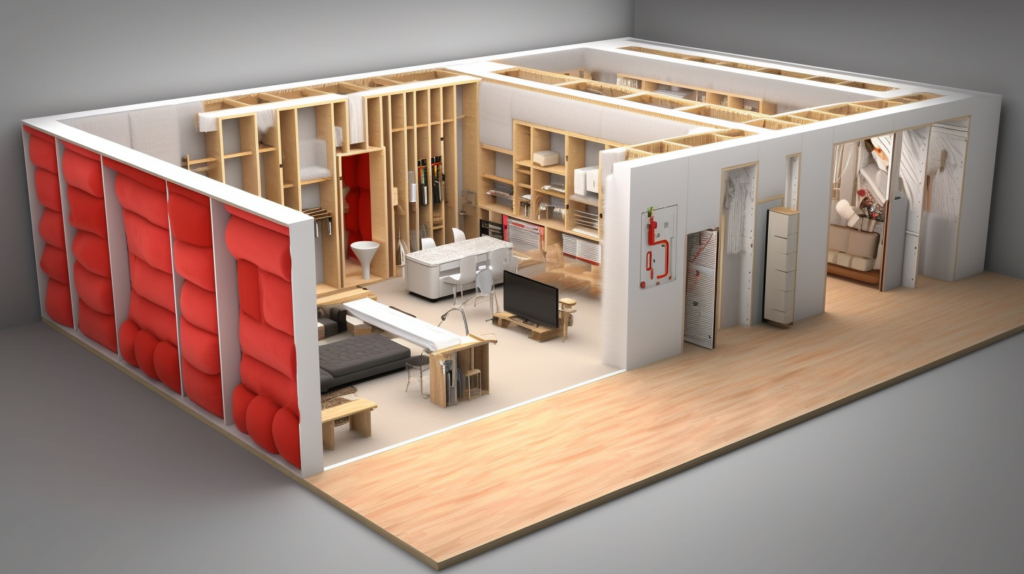Whether in a bustling downtown apartment or a peaceful suburban home, unwanted noise infiltrating living spaces can disrupt sleep, concentration, and relaxation.
Installing insulation offers a temptingly simple solution, but does filling walls and ceilings with sound-absorbing materials effectively help soundproof?
While insulation forms a key component of noise reduction, relying solely on fiberglass batts, spray foam, or cellulose to fully soundproof a building has significant limitations.
A multi-layered approach combining insulation with other specialized materials and techniques works best for comprehensive acoustic control.
Let’s dive in to explore how various insulation types absorb but don’t completely block sound, supplemental soundproofing methods that enhance effectiveness, optimal installation areas, and a complete noise reduction system.
How Does Insulation Work To Block Sound?

Insulation can absorb and dampen noise vibrations to provide sound blocking and noise control, however not all insulation types work equally well for acoustical applications.
The primary mechanism by which insulation reduces sound transmission is through sound absorption.
When sound waves encounter an insulating material, the acoustic energy is transferred into the insulation and converted into very minor amounts of heat energy rather than continuing to travel through the molecules.
The degree to which an insulating product can absorb and attenuate noise depends largely on the density and thickness of the material.
As a general rule of thumb, the denser and thicker the insulation, the better it will perform at reducing sound transmission.
This is because higher density materials have more mass to reflect sound waves, while increased thickness provides more area for the acoustic energy to get trapped and converted into heat.
Insulation designed specifically for soundproofing leverages these properties to optimize noise blocking.
Acoustical insulation contains materials chosen particularly for their molecular properties and density configurations that enable superior interaction with sound wave frequencies within the range of human hearing.
When sound waves encounter these optimized materials, the acoustic energy causes the insulation fibers and molecules to vibrate slightly and dissipate the kinetic energy as converted heat.
The more the insulation dampens the sound waves internally via absorption and dispersion, the more “acoustically dead” it becomes, dropping the noise levels.
Common materials known for excellent sound absorption include fiberglass, rock wool, open and closed-cell foam, and other insulation types engineered for noise control.
What Types Of Insulation Are Best For Soundproofing?

When selecting insulation materials for optimal soundproofing and noise control, fiberglass and rock wool insulation typically provide the best all-around acoustic absorption and transmission loss capabilities.
While other insulations like cellulose and spray foam can also dampen noise, they generally require much greater thicknesses to achieve equivalent sound blocking compared to superior options like fiberglass and rock wool.
Here is an in-depth look at the common insulation types ranked from most to least suitable for soundproofing:
Fiberglass insulation is composed of small interlaced glass fibers bonded together, generally at densities ranging from 0.5 to 6 pounds per cubic inch.
Higher density fiberglass insulation with tightly packed fibers provides optimal noise reduction ratings, as the increased density improves sound reflection and absorption.
Fiberglass absorbs and traps sound waves within its fibers rather than transmitting noises through wall and floor cavities.
It is an affordable, readily available insulation material that effectively dampens sound when installed properly.
Rock wool insulation, also referred to as mineral wool, is a type of insulation made from natural or slag-based rock that is melted and spun into dense fiber clusters resembling fiberglass.
It typically has a slightly higher density than standard fiberglass, ranging from 0.5 to 5 pounds per cubic foot.
The higher density rock wool fibers have enhanced sound dampening capabilities compared to traditional fiberglass insulation.
Rock wool more effectively converts sound wave energy into heat as it passes through the dense material, reducing transmission.
It is commonly installed in interior walls and floor/ceiling assemblies specifically to control noise.
Cellulose insulation is made from recycled paper fibers or other plant materials and has a relatively low density between 0.7 and 1.5 pounds per cubic foot.
While cellulose can provide reasonable sound absorption when installed very thickly in walls and ceilings, it usually requires around 50% greater thickness than fiberglass or rock wool insulation to achieve comparable sound transmission loss performance.
For this reason it is rarely an optimal choice acoustically on its own, unless used in combination with other insulations or soundproofing methods.
Spray polyurethane foam (SPF) insulation has a low density, typically ranging from 0.5 to 2 pounds per cubic inch. It can assist in reducing noise infiltration by sealing gaps and cracks through which sound leaks can occur.
However, spray foams do not have as much inherent sound absorbing ability as denser insulations like rock wool and fiberglass.
Spray foam insulation is best paired with additional acoustical insulation materials to optimize air sealing and improve damping.
Does Insulation Effectively Soundproof On Its Own?

While materials like dense fiberglass and rock wool provide very good noise absorption and blocking within walls, floors, and ceilings on their own, insulation alone is rarely enough to achieve maximum soundproofing in buildings.
There are several limitations to relying solely on insulation for acoustic control:
Insulation lacks mass and weight – Adding mass is crucial for preventing noise transmission as it blocks sound waves and dampens vibrational energy.
Supplementary materials like plywood, OSB boards, and multiple layers of drywall are needed to add mass and improve sound blocking.
Insulation does not isolate structure-borne sounds – Specialized products like resilient channels or isolation clip systems are required to decouple wall finishes from studs/joists.
This minimizes transfer of noise through the actual building structural elements, not just the cavities.
Insulation can leave gaps – Small cracks, openings around wires, or poorly sealed edges of insulation enable noise to flank around the material through paths of least resistance.
Diligent air sealing is vital. Insulation quality varies – Not all insulation is created equal in terms of uniform density, installation quality, and noise control abilities.
Products specifically designated for acoustics decidedly outperform standard thermal insulation.
For these reasons, a multifaceted approach combining insulation with additional soundproofing techniques like isolation and damping provides superior noise control compared to just insulation by itself.
Strategically pairing high quality acoustic insulation with sealing, resilient channels, multiple drywall layers, and other methods yields optimal sound transmission loss.
While a key component, insulation alone is insufficient for comprehensive soundproofing.
Other Tips For Enhancing Soundproofing Performance

Although insulation should form the core foundation of any residential or commercial soundproofing system, a diverse approach covering all potential noise infiltration paths works best.
Along with installing high density, purpose-designed acoustical insulation in walls and ceilings, consider these supplementary tips for boosting noise reduction:
Perform comprehensive air sealing – Thoroughly caulk and seal any penetrations, cracks, holes or openings throughout the building envelope that allow sound transmission from one space to another.
Acoustical sealants dampen rather than transmit vibration, preventing flanking noise through leaks.
Even small gaps can transmit surprising amounts of noise if left unsealed.
Incorporate sound isolation hardware – Adding metal resilient channels or isolation clip systems that physically decouple wall finishes from the main framing studs/joists can markedly improve acoustic performance.
This eliminates a key noise transfer path that insulation alone cannot address.
Look for products rated for optimal sound transmission loss.
Utilize multiple layers of drywall – Using two or more layers of drywall on walls and ceilings adds damping mass that can further enhance soundproofing capabilities, especially if the seams are staggered between layers.
5/8 inch drywall outperforms 1/2 inch, and multiple layers are ideal.
Install sound-dampening mats or underlayments – Acoustical mats and underlayments contain layers of viscoelastic polymers that reduce noise transmission when placed under flooring, at floor-wall junctions, or above subfloor.
This procedure is particularly helpful for attenuating impact noise and footfall sounds.
Upgrade to sound-rated wall and window assemblies – The thicker the walls, ceilings, doors, and windows, the more noise transmission through them can be reduced, particularly lower frequencies.
Sound transmission class (STC) and outdoor-indoor transmission class (OITC) ratings signify optimal acoustic performance constructions, often using multiple layers and strategic materials to block sound.
A comprehensive approach combining these complementary soundproofing materials and techniques along with appropriate insulation addresses the full range of potential airborne and structure-borne noise infiltration paths for maximal acoustic control.
There is no single cure-all product, but rather the sum total of upgrades and installations secures the desired noise reduction.
Where Should Insulation Be Added For Optimal Soundproofing?

Any building junction or envelope area that presents a potential channel for noise transmission should be considered for sound-absorbing insulation installation. Prioritize these aspects of your home or building spaces when planning acoustical upgrades:
Interior partition walls between rooms – Insulate thoroughly with faced fiberglass or rock wool batt insulation for wall cavities that serve as sound barriers between living spaces. Acoustical caulk perimeter edges for optimal effect.
Floor-ceiling assemblies between occupied stories – Insulate floor joist cavities above living areas to absorb footfall noise. Fiberglass or rock wool work well here. Pair with rug pads and acoustical floor underlayments.
Attic spaces above top occupied floors – Blown-in loose-fill cellulose or fiberglass over top story ceilings helps insulate noise transfer to rooms below. Thickness of at least R-30 is recommended.
Basement and crawl space ceilings – Apply thick mineral wool batts or spray foam insulation directly to basement ceilings and exposed subfloors to reduce noise infiltration from above and provide damping.
Band joists and rim joists – Incorporate spray foam insulation, caulk, or sealants within the narrow cavities between floor joists along the perimeter band joist to combat flanking sound leaks.
Targeting these common sound paths for comprehensive insulation installation paired with proper air sealing noticeably reduces noise transmission throughout the building envelope.
Combining insulation upgrades with other soundproofing techniques yields optimal acoustic control. Proper insulation coupled with diligent air sealing can eliminate many noise infiltration routes.
Conclusion
Using insulation is a key strategy for reducing noise transmission through walls, floors, ceilings, and other building cavities.
However, to achieve robust soundproofing, insulation should not be solely relied upon.
A multi-faceted approach that incorporates insulation with air sealing, mass-adding materials, isolation hardware, and specialized acoustical products offers the best noise control.
Fiberglass and rock wool insulation provide excellent sound absorption when installed thickly and uniformly in sound flanking paths.
But also carefully sealing gaps, using multiple drywall layers, isolating wall finishes, and upgrading to sound-rated assemblies enhances effectiveness.
Comprehensive upgrades to address both airborne and structure-borne noises are ideal.
With diligent installation of appropriate insulation types paired with complementary soundproofing materials and techniques, both professionals and homeowners can successfully reduce unwanted noise infiltration.
